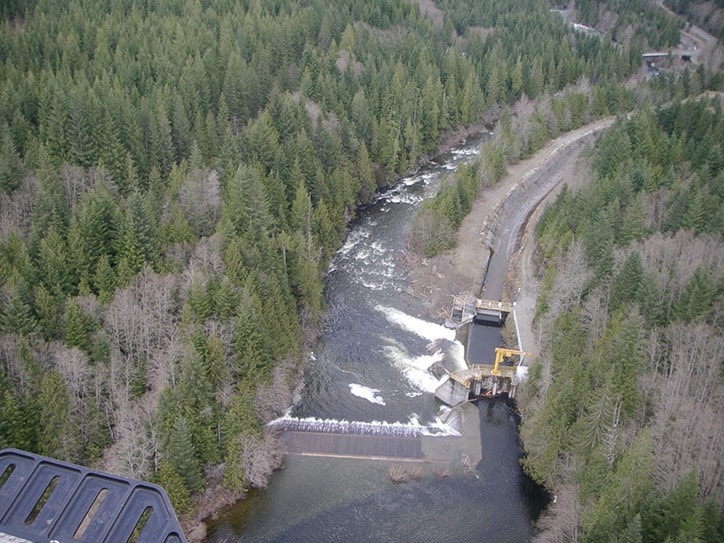BC Hydro is moving closer to starting capital upgrades to the Salmon River Diversion facility, located north of Campbell River. The facility, built in the 1950s, diverts water from the Salmon River into the Campbell River system for power generation and other water use interests.
BC Hydro is looking at improvements that include dam and canal upgrades, upstream adult fish migration and downstream fish out-migration. All of these elements would provide improved reliability, debris management, and access to about 40 kilometres of ideal fish habitat located upstream of the dam.
“This project is about dam safety, environmental improvements for fish, and worker and public safety,” says BC Hydro’s Stephen Watson. “This facility is an important asset to BC Hydro for the Campbell River system and significant improvements are planned.”
“BC Hydro has been working the past few years to come up with good solutions for all the project components,” said Watson. “This year we’ll work to develop design for a very good and operational adult fish passage and plan for construction to take place in 2016, with it being fully operational for the coho migration in fall 2016. We are also proposing upgrade work on the dam and the debris management works in 2016. From there, in 2017, work will take place on a fish screen and upgrades to the concrete canal that runs downstream of the dam for about 3.5 km. All works are planned to be complete by 2018.”
“BC Hydro’s schedule goal was to have adult fish improvements in place by fall 2015, though the details and work required in looking at all the potential fish passage options were significant and unfortunately we’re not going to make that date,” adds Watson. “We wanted to do this right and we’re happy with the final solutions in place, particularly how the adult fish passage works decision was collaboratively arrived at with First Nations, government fish agencies and BC Hydro. BC Hydro is thankful and very appreciative of First Nations and agencies time and effort in this process.”
BC Hydro is leading the dam safety and fish screen upgrade works, but the adult fish passage component of the project was co-managed by BC Hydro, We Wai Kai and Wei Wai Kum. It’s the first time BC Hydro has directly involved First Nations in a capital project decision. The K’omoks First Nation was also involved in the technical committee.
“I can certainly say that it was a big learning process in how BC Hydro undertakes their capital projects,” says We Wai Kai Council member and representative to the project, Brian Assu. “As their Coastal Chair of the Fish and Wildlife Compensation Program, I have good knowledge of the hydroelectric system but this process, with BC Hydro’s engineers, biologists and consultants, was taken to a new level and there was a ton of information to go through. I’m not sure if I needed to know all that was presented, yet at the same time it was presented to us in a cohesive way and in a way that we could make the best decision for salmon fish passage past the dam in consideration of the various factors at the site.”
In December, BC Hydro used a structured decision making process and used an external facilitator to bring the group to a consensus recommendation on the new type of upstream fish passage. Consideration was given to a range of evaluation criteria including: success of fish moving upstream, operations and maintenance, worker and public safety, environmental impact, and cost. A new fish ladder on the right bank of the river was the consensus recommendation which will require removal of the existing fish ladder as there is some overlap to where the new ladder will be located.
“First Nations were in this process to make improvements for fish and to get more fish productively, whether it be steelhead or coho, on the Salmon River,” says Wei Wai Kum Councillor and also a representative on the project, Tony Roberts Jr. “We have made a decision that will help fish and I am appreciative of everyone’s involvement to get to this stage. At the same time we need to continue to work hard so we can get these works in place.”
BC Hydro has a community liaison committee in Campbell River and will be providing a project update in February.
“BC Hydro would like to acknowledge the Campbell River Salmon Foundation and the Sayward Fish and Game Club for their keen interest in fish on the Salmon River, and in many ways, this milestone is to be shared with those volunteers,” adds Watson.
Historically since the diversion dam was constructed, the water diverted from the Salmon River represents about 10 per cent of the Campbell River system water flows. Minimum river flows on the Salmon River below the diversion dam were more than doubled about 10 years ago out of consideration for fish on that system.
